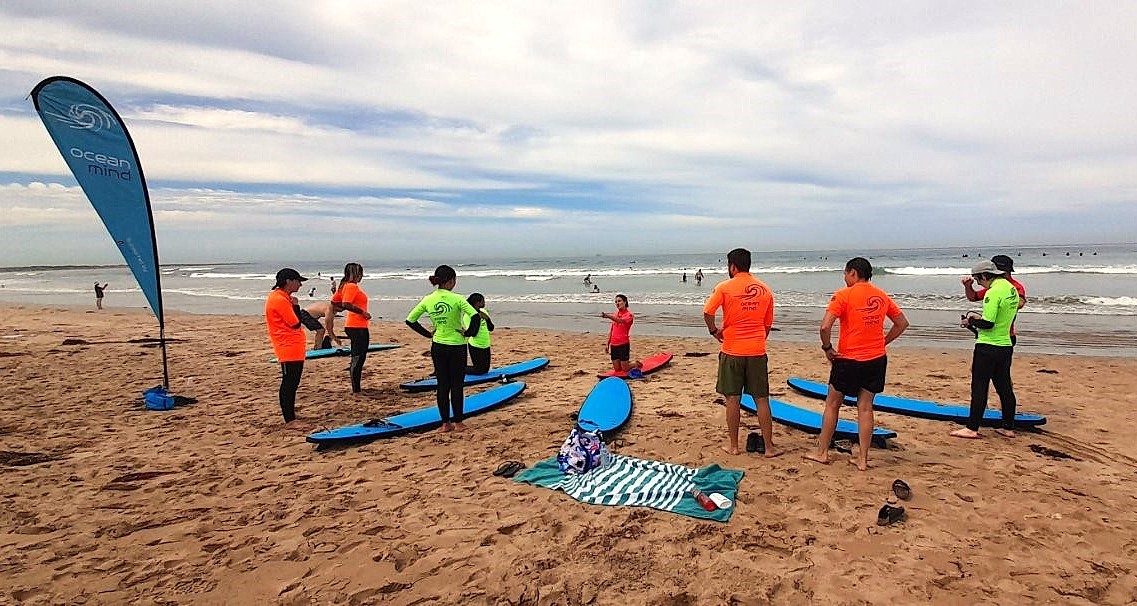Estimates are that up to 30 per cent of school-aged children – or 1.2 million – across Australia may be facing medical or mental conditions serious enough to affect their attendance and education, with 14 per cent experiencing one or more mental disorders.
It’s a startling state of affairs and a crisis desperately in need of more research and government attention.
So why have school refusal numbers exploded, and why are so many kids not attending school for reasons other than truancy?
Sam Barrett is social innovations head at Melbourne City Mission (MCM). He’s worked in youth services for 25 years in Adelaide, Sydney and Melbourne, and while he’s mainly been working in and around youth homelessness, he also has extensive experience in community development and mental health.
“My experience on the ground is that there’s a couple of coinciding things going on,” Barrett says.
“One is what I would call, ‘a rights movement’ or a sense of autonomy. Generationally younger people these days have realised that they have rights to say no to things.
“There’s a much clearer concept in the younger generations that they are in charge of their own lives, which is good, but also, I think the side effect of that, and COVID probably exacerbated it, is that they can say, ‘well, I’m in charge of going to school, and I don’t want to go to school today, so I’m not’.”
It’s part, Barrett says, of a broader body autonomy or sense of independence that people have at a younger age now, far more than would have been the case back in the ‘70s and ‘80s, for example.
The other pertinent contributor, Barrett contends, is young people’s attention spans and the availability of information.
“You know, quick, rapid information,” he explains.
“And I think that the traditional sense of school, that you’ve got young people sitting in chairs and there’s an adult in the room handing information to them, that’s increasingly out of step with the way that people get information in the last 20 years...”

“We think there’s application into the public school environment for a program like this to sit in any school environment,” Sam Barrett says. “We think it would be a really valuable addition.”
To cater to the nation’s rapidly escalating school refusal case numbers, new approaches it seems are required, built around evidence and experience.
On a Mission to get them back at school
MCM has been around since the gold rush of the 1850s. In 2012 it launched Hester Hornbrook Academy as a humble one-classroom affair, after it was identified that numerous young people in MCM’s homelessness and support services had an appetite for education, but their presentation, mental health, behaviour, or their experience of school, had proved substantial barriers.
In response, a sensitive environment was created for young people to learn. The school now has four campuses and caters to around 500 students.
Principal Sally Laslett says students come to the school with very little, if any, attendance in school, and so her team’s work is to understand the educational gap and fill it so that they feel success in learning and want to engage in school.
“So the data we have is, to begin with, minimal, but really it’s around what are the barriers to education, and that often includes the wellbeing support, it might be food, it might be shelter, it might be connection to the justice system, or whatever it is.
"How do we remove those barriers so that our young person can engage in learning?” Laslett says.
The catch line of the academy, Barrett says, is ‘wellbeing for learning and learning for wellbeing’.
“So it’s really trying to shape a school that accepts that people’s behaviour might not be up to scratch for learning today, but tomorrow, we’ll give it another go – and understanding trauma, and that behaviour has function.
“It’s about looking at everything you do through that lens, ‘why is that person doing that thing?’ or, ‘let’s try and understand the function that that is giving that person’ rather than punishing them or showing them rules.”
Living Learning – a new approach
One of Barrett’s main roles is overseeing Living Learning, an Australia-first pilot program, that connects students with medical and mental health support on top of helping them to attend class.
Funded by the Gandel Foundation, the Paul Ramsay Foundation, the Lord Mayor’s Charitable Foundation, the Helen MacPherson Smith Trust and the Ross Trust (who comibined have invested $4 million into the initiative), the program came about as a response to a Victorian Government call out for expressions of interest for innovation projects in education and mental health.
It’s part of what are called ‘partnerships addressing disadvantage’ and ‘social impact investing’, a method of funding projects where governments can see actual cost saving happening because of specific projects doing exactly what they say they’re going to do.
“...we knew that there was a cohort of young people who we couldn’t effectively work with because they would turn up at school for a bit, and then they would disappear,” Barrett says.
“And we knew that they needed school, that they were keen, but there were a whole lot of social or medical or emotional things going on for them that meant that they couldn’t reliably come and they weren’t getting an education.”

The exact number of Australian students who drop out due to their mental health is not known, but the nation’s apparent school retention rate for Years 7 to 8 dropped 1.4 per cent from 2022-23 to 79.1 per cent, Australian Bureau of Statistics data shows.
Living Learning works with this particular cohort of young people, partially within the school, but also partially outside of the school, in a highly flexible and very individualised way.
“So we’re throwing all of the resourcing at those young people and see if we can shift that metric – the metric being emergency department presentations that we use to measure it,” Barrett explains.
“So it’s interesting in that we’re nominally an education input, but we’re measuring a health spending outcome.”
Multi-disciplinary teams working together
It’s a five-year pilot project due to finish in 2025.
With an age range of 15-24, most of the 144 students engaged in Living Learning are 17 or 18 years old.
“We’re very data-driven, and we found that the average gap in enrolment between when they enrolled with us and their last time that they attended school, on average, is more than one year, which actually surprised us.
“We were thinking that it would be shorter than that, but yeah, that’s a stunning stat, that there’s a lot of young people sitting around doing nothing for two or three, four years, and there’s no safety net for that.”
The program uses an innovative case management strategy, where a multi-disciplinary team works with each student.
“So in that we want educators, we want youth workers, we want allied health professionals, so psychologists and occupational therapists, in our team all working together on the same project at the same time,” Barrett says.

A key component of the program is the availability of adventure activities such as bushwalking, canoeing, surfing and camping, along with a range of on-campus classes involving art therapy and music.
It’s about rapid access to the different disciplines.
“…for this group of young people, that act of meeting one person and then having to go to a foreign place to meet another person, to go to a psychologist, for example, that’s the problem.”
Straight off the bat, the team seeks to understand what the young person’s needs are.
“So for one young person, we might drive them to and from school for a month, and because we’ve decided that that is the real impingement, that they don’t feel safe out in the community ... we work on that, and see if that makes a difference.”
At the other end of the scale, there are young people dealing with other layers of complexity, be they mental health problems, social and emotional issues, or maybe they are in and out of homelessness.
“So with those people, it’s really trying to coordinate services and really catch the young person when they’re around,” Barrett says.
“Some people are quite transient, so some of our most high needs young people, we’ll be able to work with them for a week, and then they disappear for two weeks, and you can’t do anything.
“And then they’ll come back to you, and you have to work in a really stop/start way.”
But Barrett says the program is designed to cater to that, and that’s the key – it’s so flexible and so student-centred that there are very few expectations that the young person is going to conform to a certain setup.
“…it’s all about meeting the young people where they are, and being really authentic with them...
“We haven’t met a single person who doesn’t want to go to school or get an education,” Barrett says.
“It’s just trying to unlock, how they put together a desire to go to school, and the actual functionality of being able to get yourself to school, be on campus with other students, talk to your teacher, do the work, understand the work.
“All of those things are unique for each student.”
Laslett says Living Learning’s holiday programs are another reason for its success.
“…the holiday programs, for me, are the added bonus, because what we know is that young people over the holidays need supports and don’t have them in place often, and being able to continue that support right through any school holiday period is essential, and if Living Learning wasn’t there, we don’t know how we would do that at a school.”

Eight out of 10 students involved in Living Learning are currently, or will soon be, working or studying, while three quarters have attained literacy and numeracy skills allowing them to pursue technical or further education.
Outcomes and results
For most students, once their confidence rises to a point that they’re happy to be in classes, they move out of the program and into the broader Hester Hornbrook Academy.
Eight out of 10 students involved are currently, or will soon, be working or studying, while three quarters have attained literacy and numeracy skills allowing them to pursue technical or further education.
“I think, in terms of academic outcomes, broadly across our cohort, we use the bksb tool to measure literacy and numeracy, and broadly, everybody is increasing their level in bksb – and the Living Learning cohort are going faster than the non-Living Learning cohort at Hester,” Barrett says, proudly.
“So we can show that our program’s methods are really consequential to an outcome … and the outcome we want is that they engage well at school, they learn and that they finish school.”
Barrett would love to see a Living Learning program in every public and independent school.
“Many schools probably don’t have the capacity or the skills or the approach to really do much about [students who refuse to go to school],” he says.
“So it’s a bit of a ‘well, we’ll see what happens tomorrow’, kind of approach and I think what we’ve done here has proved that, with the right ingredients and the right funding and the right approach, we can have an effect on really entrenched people that have been out of school for years.
“We’ve turned them around by understanding their needs and putting in individualised approaches.”
Barrett says he understands that if Living Learning was placed within a mainstream school, the dynamic would require altering and adapting, but the main tenants still stand.
“There’s often quite a complex array of things stopping people from going to school, and as long as you understand them and apply some flexible approach to it, it’s pretty straightforward getting a good result.
“Because the young people want that and the parents want that and schools want it, yeah?”














